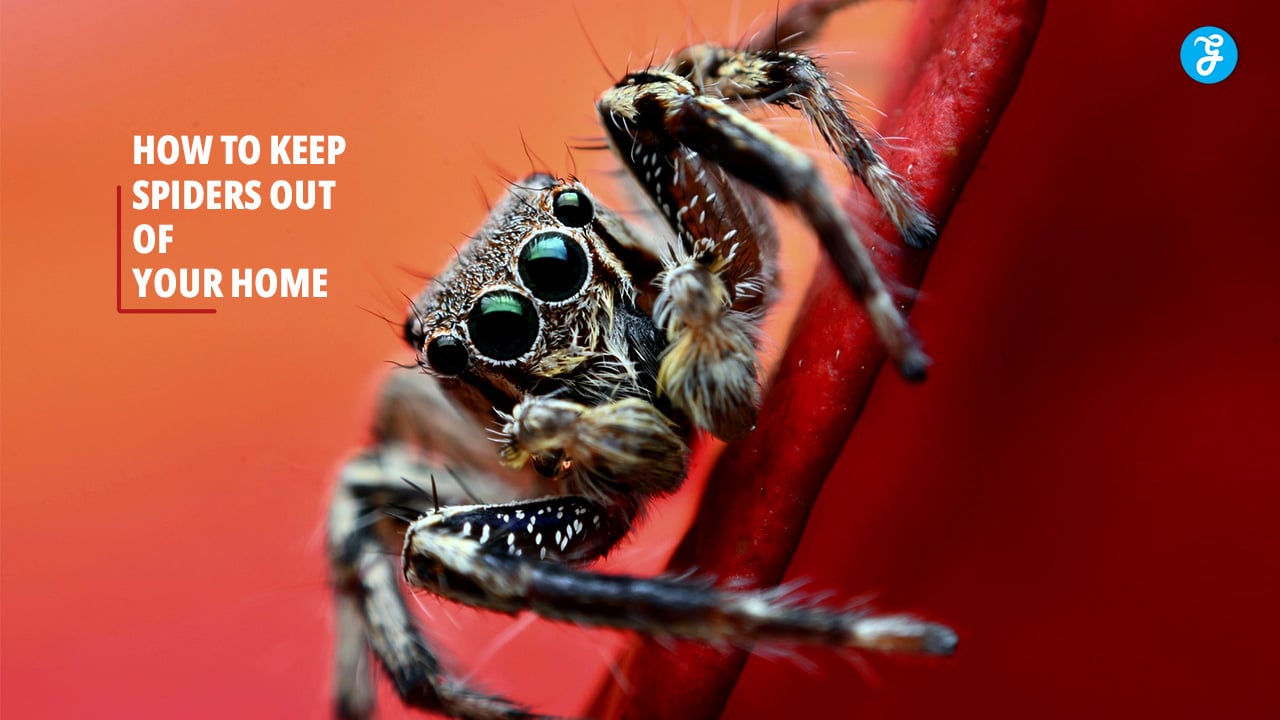You’re relaxing on your couch, enjoying a quiet evening at home, when suddenly you spot a spider scurrying across the floor. For many of us, this scene is all too familiar and can quickly turn a peaceful moment into one of unease. While spiders play a crucial role in our ecosystem by controlling other insect populations, their presence inside our homes is often unwelcome. But fear not! This comprehensive guide will walk you through 10 effective, easy-to-implement techniques to keep those eight-legged visitors where they belong – outside your home.
Whether you’re dealing with common house spiders or more concerning species, these methods will help you create a spider-free sanctuary without resorting to harsh chemicals or expensive treatments. From natural repellents to smart home maintenance practices, we’ve got you covered with practical solutions that are safe for your family, pets, and the environment. So, let’s embark on this journey to reclaim your home from unwanted arachnid guests and restore your peace of mind.
1. Seal Entry Points: Your First Line of Defense
Imagine your home as a fortress. Just as a castle has its weak points, so does your house when it comes to spider invasions. The key to keeping spiders out is to identify and seal these entry points.
Here’s how to fortify your home:
- Conduct a thorough inspection: Walk around the exterior of your home, paying close attention to the foundation, walls, and roof line. Look for any cracks, gaps, or holes that could serve as spider highways into your house.
- Focus on common entry areas: Windows, doors, vents, and areas where pipes or wires enter your home are prime spots for spiders to sneak in.
- Use the right materials: For small cracks, a high-quality silicone caulk works wonders. For larger gaps, consider using expandable foam insulation.
- Don’t forget the details: Install or repair weatherstripping around doors and windows. Even a tiny gap can be an open invitation for spiders.
- Check your screens: Ensure all window and door screens are intact and properly fitted. Replace or repair any damaged screens promptly.
Pro tip: Use a flashlight to inspect your home’s exterior at night. Shine it along walls and foundations – any gaps or cracks will be more visible as light shines through them.
By sealing these entry points, you’re not just spider-proofing your home; you’re also improving its energy efficiency. It’s a win-win situation that can lead to lower energy bills and fewer uninvited guests.
2. Keep Your Home Clean and Clutter-Free: Decluttering for Spider Prevention
Spiders are nature’s minimalists – they love quiet, undisturbed spaces where they can build their webs in peace. By keeping your home clean and clutter-free, you’re essentially removing their ideal habitats.
Here’s your action plan for a spider-unfriendly home:
- Implement a regular cleaning schedule: Vacuum at least twice a week, paying extra attention to corners, under furniture, and along baseboards. These are prime spider real estate areas.
- Dust with purpose: Use a microfiber cloth or duster to wipe down surfaces, including window sills, door frames, and ceiling corners. This not only removes spider webs but also eliminates their food sources – dust mites and other tiny insects.
- Tackle your storage spaces: Basements, attics, and garages are spider havens. Organize these areas using plastic storage containers with tight-fitting lids instead of cardboard boxes. Spiders have a harder time climbing smooth plastic surfaces.
- Reduce clutter: The fewer hiding spots you provide, the less likely spiders are to stick around. Regularly go through your belongings and donate or discard items you no longer need.
- Keep your floors clear: Avoid leaving piles of clothes, toys, or other items on the floor. These create perfect hiding spots for spiders.
- Address moisture issues: Many spider species are attracted to damp environments. Fix any leaks and use a dehumidifier in naturally damp areas like basements.
Remember, consistency is key. A clean home isn’t just aesthetically pleasing; it’s also an effective spider deterrent.
3. Harness the Power of Natural Spider Repellents
Nature has provided us with an array of spider-repelling substances that are both effective and safe to use around your home. These natural solutions offer a chemical-free alternative to keep spiders at bay while maintaining a pleasant environment for you and your family.
Let’s explore some of the most effective natural spider repellents:
Peppermint Oil: The Spider’s Kryptonite
- Why it works: Spiders have a strong aversion to the potent scent of peppermint.
- How to use: Mix 15-20 drops of peppermint essential oil with water in a spray bottle. Spray this solution around windows, doors, and other potential entry points.
- Added benefit: Your home will smell fresh and invigorating!
Vinegar: A Multipurpose Marvel
- Why it works: The strong acetic acid smell repels spiders.
- How to use: Create a solution of equal parts water and white vinegar. Spray in areas where spiders are commonly found.
- Pro tip: Add a few drops of essential oil to mask the vinegar smell if you find it too strong.
Citrus Power: Lemons and Oranges to the Rescue
- Why it works: Spiders dislike the strong citrus scent.
- How to use: Rub lemon or orange peels along windowsills and door frames. Alternatively, you can create a citrus spray by boiling citrus peels in water, then straining and cooling the liquid before use.
Eucalyptus: A Fresh Approach to Spider Control
- Why it works: The strong, menthol-like scent of eucalyptus repels spiders.
- How to use: Place eucalyptus leaves in spider-prone areas or use eucalyptus oil in a diffuser.
- Bonus: Eucalyptus is also known for its air-purifying properties.
Diatomaceous Earth: A Natural Barrier
- Why it works: This fine powder damages the exoskeletons of spiders and other insects, dehydrating them.
- How to use: Sprinkle food-grade diatomaceous earth along baseboards, window sills, and other areas where spiders travel.
- Safety note: While safe for humans and pets, avoid inhaling the fine dust during application.
Cedar: Nature’s Pest Repellent
- Why it works: The strong aroma of cedar repels many insects, including spiders.
- How to use: Place cedar blocks or shavings in closets, drawers, and other dark spaces. You can also use cedar mulch in your garden beds near the house.
These natural repellents offer a safe, eco-friendly way to deter spiders. Experiment with different options to find what works best in your home. Remember to reapply these natural solutions regularly, especially after cleaning or in high-traffic areas, to maintain their effectiveness.
4. Reduce Outdoor Lighting: Dimming the Dinner Bell for Spiders
It might surprise you to learn that your outdoor lighting choices can significantly impact the spider population around and inside your home. Bright lights act like a beacon for insects, which in turn attract spiders looking for an easy meal. By making smart lighting decisions, you can make your home less appealing to both insects and the spiders that hunt them.
Here’s how to create a spider-discouraging lighting scheme:
Choose the Right Bulbs:
- Opt for yellow or sodium vapor lights instead of white lights. These are less attractive to insects.
- Consider using LED bulbs, which emit less heat and are less attractive to insects compared to traditional incandescent bulbs.
Strategic Placement:
- Position outdoor lights away from doors and windows where possible. This helps prevent insects (and consequently spiders) from gathering near entry points to your home.
- Use downward-facing lights to minimize the spread of light into the surrounding area.
Motion Sensors and Timers:
- Install motion-sensor lights that only turn on when needed. This reduces the overall time your lights are on, decreasing their appeal to insects and spiders.
- Use timers on necessary lights to turn them off during the late night hours when insect activity is highest.
Create a Dark Buffer Zone:
- Keep a perimeter of darkness around your house by focusing brighter lights on specific areas away from the building.
- Use lower intensity lights closer to the house and brighter ones further away in the yard or garden.
Indoor Light Management:
- Use curtains, blinds, or shades to block indoor light from shining outside at night.
- Consider using light-blocking film on windows in rooms that need to remain lit at night.
Insect-Specific Deterrents:
- For areas where you need bright light, consider adding insect-deterring features like bug zappers or ultrasonic devices to reduce the insect population without affecting your lighting.
By implementing these lighting strategies, you create an environment that’s less attractive to insects and, by extension, to spiders. Remember, fewer insects mean fewer spiders, as you’re essentially reducing their food source.
5. Web Removal: Breaking the Cycle of Spider Habitation
Regular web removal is more than just a cleaning task; it’s a crucial strategy in your spider control arsenal. By consistently removing spider webs, you disrupt their habitats and send a clear message that your home is not a suitable place for them to settle.
Here’s your comprehensive guide to effective web removal:
Frequency Matters:
- Aim to remove webs at least once a week, more frequently in high-activity areas.
- Be consistent – regular removal discourages spiders from rebuilding in the same spots.
Tools of the Trade:
- Long-handled duster: Perfect for reaching high corners and ceilings without a ladder.
- Vacuum with extension wand: Ideal for thorough removal, especially in corners and along edges.
- Cobweb broom: Designed specifically for web removal, with bendable heads to reach tricky spots.
- Microfiber cloth: Great for wiping down surfaces and catching any remaining web fragments.
Technique Tips:
- Start from the top: Begin with ceilings and work your way down to prevent webs from falling onto already-cleaned areas.
- Use a circular motion: This helps to fully wrap the web around your cleaning tool for complete removal.
- Pay attention to often-overlooked areas: Check behind furniture, under eaves, and in window corners.
Focus Areas:
- Indoor hot spots: Ceiling corners, behind doors, under furniture, around light fixtures, and in closets.
- Outdoor areas: Porches, eaves, window frames, and around outdoor light fixtures.
Post-Removal Care:
- After removing webs, wipe down the area with a vinegar solution or essential oil spray to deter future web-building.
- Consider applying a natural spider repellent in areas where webs are frequently found.
Safety First:
- Use protective eyewear when removing overhead webs to prevent debris from falling into your eyes.
- If using a ladder, ensure it’s stable and have someone spot you.
- Be cautious in dark or cluttered areas where spiders might be present.
Record Keeping:
- Keep a simple log of where and when you find webs. This can help you identify problem areas and track the effectiveness of your spider control efforts.
By incorporating regular web removal into your cleaning routine, you not only keep your home looking tidy but also actively discourage spider infestations. Remember, persistence is key – the more consistently you remove webs, the less likely spiders are to view your home as a suitable habitat.
6. Yard Maintenance: Creating a Spider-Resistant Perimeter
Your yard is the first line of defense against spiders entering your home. By maintaining your outdoor spaces properly, you can significantly reduce the spider population near your house, making it less likely for them to find their way indoors.
Here’s a comprehensive approach to spider-proofing your yard:
Landscaping Strategies:
- Keep grass short: Regularly mow your lawn to reduce hiding spots for spiders and their prey.
- Trim bushes and trees: Keep vegetation trimmed back at least a foot from your home’s exterior. This eliminates “bridges” that spiders can use to access your house.
- Use cedar mulch: Apply cedar mulch in garden beds near your home. Cedar’s natural oils repel many insects and spiders.
Declutter the Outdoors:
- Remove piles of leaves, wood, and other debris: These make perfect habitats for spiders.
- Store firewood properly: Keep it elevated off the ground and away from the house.
- Organize outdoor storage: Use sealed plastic containers instead of cardboard boxes for storing outdoor items.
Moisture Management:
- Fix leaky faucets and pipes: Excess moisture attracts insects, which in turn attract spiders.
- Ensure proper drainage: Make sure water flows away from your home’s foundation.
- Use a dehumidifier in damp areas like crawl spaces or basements.
Strategic Planting:
- Incorporate spider-repelling plants: Mint, lavender, eucalyptus, and citrus plants can help deter spiders naturally.
- Avoid excessive dense ground cover near the house: While attractive, it provides ideal spider habitats.
Outdoor Lighting:
- Use yellow or sodium vapor lights: These attract fewer insects than white lights.
- Position lights away from the house: This draws insects (and spiders) away from your home.
Regular Inspection and Maintenance:
- Check exterior walls: Look for cracks or gaps and seal them promptly.
- Clean gutters regularly: Clogged gutters can create damp conditions that attract insects and spiders.
- Inspect outdoor structures: Sheds, gazebos, and other structures can harbor spiders if not maintained.
Natural Predator Encouragement:
- Install bird feeders and baths: Many birds eat spiders and can help control their population.
- Create a lizard-friendly environment: If you live in a suitable climate, lizards can be excellent spider predators.
By implementing these yard maintenance strategies, you create an environment that’s less hospitable to spiders. This not only reduces the likelihood of spiders entering your home but also contributes to a more enjoyable outdoor space for you and your family.
7. Utilize Spider Traps: A Targeted Approach to Spider Control
While prevention is key, sometimes you need a more direct method to deal with existing spider problems. Spider traps offer an effective, non-toxic way to reduce spider populations in your home. Here’s a comprehensive guide to using spider traps effectively:
Types of Spider Traps:
- Glue Traps:
- How they work: These sticky traps capture spiders as they walk across them.
- Best placement: Along baseboards, in corners, and near entry points.
- Pros: Inexpensive, easy to use, and can catch multiple spiders.
- Cons: May also trap beneficial insects or small household pets.
- Pheromone Traps:
- How they work: These use synthetic pheromones to attract and trap male spiders.
- Best placement: In areas with known spider activity.
- Pros: Specifically target spiders, reducing bycatch.
- Cons: May be less effective against female spiders.
- Light Traps:
- How they work: Use UV light to attract insects, which in turn attract spiders to the trap.
- Best placement: Dark areas like basements or attics.
- Pros: Can attract and trap various insect pests in addition to spiders.
- Cons: May attract beneficial insects as well.
- Pitfall Traps:
- How they work: Smooth-sided containers that spiders fall into and can’t escape from.
- Best placement: Along walls and in corners where spiders frequently travel.
- Pros: Can be made at home with simple materials.
- Cons: Require regular checking and emptying.
Effective Trap Placement:
- Identify spider hotspots: Place traps in areas where you’ve seen spiders or their webs.
- Think like a spider: Position traps along walls, in corners, and behind furniture where spiders are likely to travel.
- Use multiple traps: Place several traps around your home for better coverage.
- Be patient: It may take time to see results, especially in larger areas.
Safety Considerations:
- Keep traps out of reach of children and pets.
- If using glue traps, have vegetable oil on hand to free any non-target animals that may get stuck.
- Check and replace traps regularly to maintain effectiveness.
DIY Spider Trap Ideas:
- Jar Trap:
- Coat the inside of a jar with petroleum jelly.
- Place the jar in spider-prone areas.
- Spiders will climb in but be unable to climb out due to the slippery surface.
- Cardboard Tube Trap:
- Take an empty toilet paper or paper towel tube.
- Coat the inside with a thin layer of glue or petroleum jelly.
- Place in corners or along baseboards.
- Duct Tape Trap:
- Create loops of duct tape with the sticky side out.
- Place these loops in areas where spiders are commonly seen.
8. Introduce Natural Predators: Nature’s Spider Control
Encouraging natural spider predators can be an effective and eco-friendly way to keep spider populations in check around your home. Here’s how you can create an environment that attracts these helpful creatures:
Birds:
- Install bird feeders and baths to attract insect-eating birds to your yard.
- Plant native trees and shrubs that provide natural shelter and food for birds.
- Consider putting up birdhouses to encourage nesting.
Lizards:
- If you live in a suitable climate, create a lizard-friendly environment.
- Provide rock piles or stone walls for basking and shelter.
- Avoid using pesticides that could harm lizards.
Cats:
- If you have a cat, allow supervised outdoor time.
- Remember that indoor cats can also help control any spiders that make it inside.
When introducing natural predators, it’s important to maintain a balanced ecosystem. Avoid using chemical pesticides that could harm these beneficial creatures.
9. Harness the Power of Essential Oils and Herbs
In addition to peppermint oil, several other essential oils and herbs can effectively repel spiders. Here’s an expanded list with application methods:
Tea Tree Oil:
- Mix 5-10 drops with water in a spray bottle.
- Apply around windows, doors, and other entry points.
Lavender:
- Plant lavender around your home’s exterior.
- Use lavender oil in a diffuser or mix with water for a spray.
Eucalyptus:
- Place eucalyptus leaves in drawers and closets.
- Use eucalyptus oil in a spray or diffuser.
Cinnamon:
- Sprinkle ground cinnamon in spider-prone areas.
- Use cinnamon essential oil in a spray solution.
Rosemary:
- Plant rosemary near entry points.
- Simmer rosemary sprigs in water and use the cooled liquid as a spray.
Lemon Balm:
- Grow lemon balm in your garden or in pots near doors and windows.
- Crush leaves and rub on windowsills and doorways.
When using essential oils, always dilute them properly and test on a small area first to ensure they don’t damage surfaces.
10. Professional Pest Control: When to Call in the Experts
While DIY methods are often effective, there may be times when professional pest control is necessary. Consider professional help if:
- You have a severe spider infestation that persists despite your best efforts.
- You’ve identified venomous spiders in your home.
- You’re dealing with multiple pest issues simultaneously.
- You have a large property that’s difficult to manage on your own.
When choosing a pest control service:
- Look for companies that offer Integrated Pest Management (IPM) approaches.
- Ask about their methods and whether they offer eco-friendly options.
- Ensure they’re licensed and insured.
- Discuss ongoing prevention strategies to keep spiders away long-term.
Remember, professional pest control should be a last resort after trying the natural methods outlined in this article.
Takeaway
Keeping spiders out of your home doesn’t have to be a daunting task. By implementing these 10 techniques, you can create an environment that’s far less appealing to our eight-legged neighbors. From sealing entry points and maintaining a clean home to using natural repellents and encouraging spider predators, you now have a comprehensive toolkit for spider prevention.
Remember, the key to success is consistency and a multi-faceted approach. Don’t rely on just one method; instead, combine several techniques for the best results. And while it’s natural to want a spider-free home, it’s also important to remember the vital role spiders play in our ecosystem. The goal is to create a balance where your living space remains comfortable for you while respecting the natural world around us.
By following these guidelines, you can enjoy a home that’s largely free from unwanted arachnid guests without resorting to harmful chemicals or extreme measures. Here’s to peaceful, spider-free living!










































